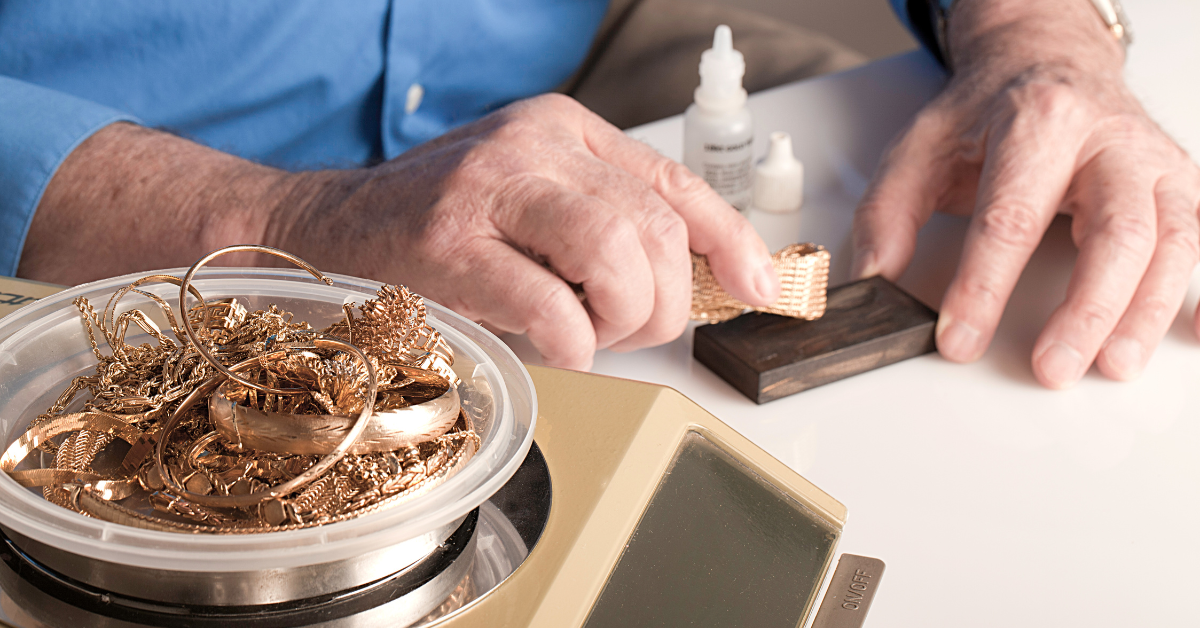Testing the “realness” of gold is easier than one might imagine. Before we dive into the different methods for confirming whether an object is golden, there are a few rules of thumb to keep in mind.
First, we need to define what a hallmark is, and the purity indicators associated with both the millesimal fineness scale and the karat system.
A hallmark is an official stamp commonly imprinted on precious metals that is meant to indicate composition and purity. If it’s put there by a trustworthy source, it can sometimes be the easiest indicator for determining whether an object is gold. However, hallmarks can be fake, so they are not always a foolproof indicator.
The millesimal fineness scale measures the purity of gold in parts per 1000. As an example, a hallmark showing a millesimal fineness of 850 would mean that the makeup of an object is 850 parts of pure gold out of 1000.
The karat is a unit of measurement under a different system, which denotes how much gold is in an object relative to other metals in its composition. Common examples of valid purity numbers under the karat system include 24k, 18k, 14k, and 10k. One karat is equal to 1/24 part of pure gold in an alloy. For example, an 18k, or 18/24 gold item is made up of 75% gold, with the additional 25% containing other metals.
Methods for Testing if an Object is Gold
Check for a Hallmark
As we mentioned previously, finding a hallmark on a gold object or piece of jewelry is often the easiest method to confirm whether it’s authentic. On a ring, the hallmark is usually found on the inner band. Necklaces and bracelets often have hallmarks near their clasps. Gold bullion and jewelry crafted in America usually have hallmarks using the karat system, while European gold more commonly uses the millesimal fineness scale.
Remember, a hallmark (or lack thereof) is not definitive proof that an object is real gold. It’s also worth noting that if you have a gold object with a hallmark below 10k, or .417 on the fineness scale (41.7% purity), it’s considered to be fake.
Finally, hallmarks can also be used to determine whether an item is gold plated. All of the following marks indicate some form of gold plating:
- GP (Gold Plated)
- GF (Gold Filled)
- GE (Gold Electroplated)
- GEP (Gold Electro Plated)
- HGP (Heavy Gold Plated)
- HEG (Heavy Gold Electroplated)
The Water Test
One of the simplest tests that can be conducted to determine if your gold is real is to drop it in a bowl of water. Gold is a heavy metal, so if the object has a high purity level, it should sink to the bottom with ease. If it floats, it’s probably fake.
However, just because a golden-colored object sinks does not necessarily mean it’s real gold. Other metals within its composition could also cause the object to sink, so we recommend conducting some of the other tests below.
The Magnet Test
Gold is not a magnetic metal. If you have a magnet handy and you bring it near a golden-colored object, you shouldn’t see any attraction if it has a high level of purity. However, this too doesn’t necessarily confirm an object is pure gold. Jewelry is often made with a mix of silver, which is also not magnetic. If you do see an attraction, your object might be gold plated or contain a fair portion of iron or nickel.
The Skin Test
If you’ve been wearing a piece of jewelry for days, weeks or months at a time, try taking it off and looking at your skin. If you notice any discoloration, the object you’ve been wearing is likely not pure gold. Colors like green or blue can indicate oxidation, which is common with metals like copper. Pure gold does not oxidize from normal wear, so it’s fair to say if you’ve been wearing jewelry at length and notice no color on your skin, it’s likely on the pure side.
The Ceramic Test
Another simple test that can be conducted involves the use of ceramic. Find a piece of unglazed ceramic around your home and try gently scraping your gold on its surface.
If your gold is real, you’ll likely notice small flakes or scrapes that are golden in color on the ceramic. If you see the color black on the ceramic, your gold is likely not real.
The Nitric Acid Test
The nitric acid test is a relatively foolproof method to determine if your gold is real. This test involves making a small scratch on your gold (try to find an area that is not normally visible), using a nail file or black stone. The goal is to scratch just enough below the surface layer of your gold and then place a small drop of nitric acid where the scratch has been made. If you don’t notice a reaction, it’s safe to say the object is real gold. If other metal alloys are present or if the object is gold plated, you will see the colors green and/or milky white emerge.
Nitric acid testing kits are easily purchased online, but it’s important to remember that nitric acid can be a dangerous chemical. The right precautions should be taken when conducting an acid test. It’s flammable and can irritate the eyes and skin. It’s important to wear both goggles and gloves and keep your distance from heat or anything flammable. Conduct this test in a well-ventilated area.
The Vinegar Test
Another form of acid test, using vinegar on gold is a simple, safe, and cost-effective method to test if it’s real. It also doesn’t require scratching the surface of an object. Using an eye dropper, place a drop of vinegar on an inconspicuous location on your gold. If the spot changes color, the metal is not real gold.
Do you have gold scrap you’d like to sell?
You can ship your lot to Manhattan Gold & Silver. We can assay, weigh, and pay you for gold at a fair price based on the current London market fixing.
If you have any questions or would like to discuss selling precious metals, get in touch with us today by phone or using our online contact form.












